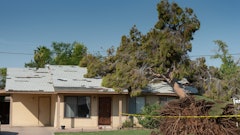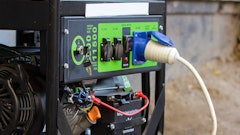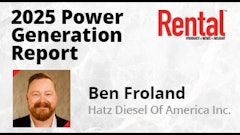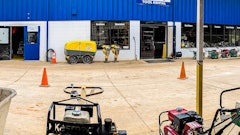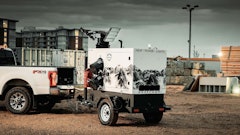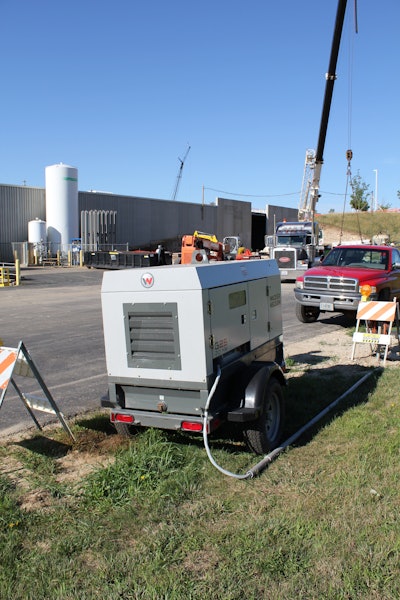
For the past several years, trends in generator design have predominantly centered on meeting tiered emissions regulations. Today, equipment owners are beginning to accept the latest changes resulting from Tier 4 Final and are looking for machines that are both economical to run and provide top-notch performance.
“The industry was really struggling with adoption — from an economic point of view, but also from a performance point of view,” says Todd Howe, product marketing manager - generators, Doosan Portable Power. With Tier 4 acceptance growing, manufacturers are moving on to the next step. “We as manufacturers have been hard at work on performance issues, and getting the robustness and reliability back into the product from where it was challenged by the aftertreatment and increased diagnostics on Tier 4 machines.”
Onboard Load Management
Currently, manufacturers are turning their focus to things such as onboard load management strategies that supply supplemental load on demand to keep the generator running optimally for ideal performance.
Some manufacturers are doing this by packaging load banks on their machines for when a load is lower than ideal. In those cases, load banks apply the necessary load to the generator and convert or dissipate the resultant power output of the source. The purpose is to accurately mimic the operational or “real” load that a power source will see in actual application. Unlike the “real” load, which is likely to be dispersed, unpredictable and random in value, a load bank provides a contained, organized and fully controllable load.
Doosan has gone in a different direction. “We’ve created a load management system that doesn’t address it from a load standpoint. Instead, it addresses it from aftertreatment temperature,” says Howe. “When that temperature is at the right level, the aftertreatment system works as intended and there are no plugged diesel particulate filters (DPFs) or any of the other issues that might affect aftertreatment.”
Plugged DPFs remain a concern. According to Ben Froland, product manager - global power generation, Wacker Neuson, “Oversizing/underloading of generators continues to cause issues. In the past, it was wetstacking on Tier 3 emissions products. With Tier 4 Interim engines, it was plugging of the DPF. The end users still want larger units than their applications demand just in case they need more power. Plugged DPFs have customers leery of that technology without some way of mitigating the plugging risk or eliminating the DPF altogether. The onboard loading ensures that the engine is always at operating temperature and that the aftertreatment system is functioning properly.”
Wacker Neuson offers a Liquid Heat Generator (LHG). The engine-mounted device generates heat by “shearing” engine coolant between stationary and rotating chambers. As a result, the engine operating temperature, in-cylinder temperature and exhaust gas temperature are all raised to levels ensuring trouble-free operation. In addition to addressing low load conditions, the LHG enables a diesel generator to perform reliably in extremely cold environments. It operates seamlessly without operator input, and disengages via a clutch when load/engine temperature is adequate, so the generator experiences no loss of available power output.
Doosan packages a heating element in the exhaust system. “When you turn the heater on, it’s like adding load to the generator, but we take the heat generated... and put it directly into the aftertreatment,” says Howe. “Rather than having to turn on a load bank and add maybe 50 kW of load to keep a unit healthy, we can turn on the heating unit, and with about 15 or 20 kW of load, keep aftertreatment temperatures where they need to be for good performance.
“The entire process takes place without the customer needing to do anything,” he adds. “There are no controls or switches. It’s monitoring engine temperature and engine parameters. Whenever one of those things signals the need for the system, it turns on automatically and takes care of itself.”
Parallel Performance
Manufacturers are also focusing on the need for flexibility. To that end, Kohler Power Systems offers its Mobile Paralleling Box, which allows users to combine different size generators with different fuel types. The paralleling box is specifically designed for use with Kohler’s gaseous and diesel mobile generator line.
“This will bring a new level of customization to a wide variety of applications,” says Anne Feudner, product manager, Kohler Power Systems. “It allows users to mix and match different size generators to meet job requirements. Four of the new boxes can be used to parallel as many as eight generators.”
The Decision-Maker 3500 digital controller, which is standard on all of Kohler gaseous and Tier 4 Final diesel mobile generators, provides the paralleling intelligence and network communications for remote monitoring. “Any Kohler mobile generator with the Decision-Maker 3500 digital controller will work with the Mobile Paralleling Box,” Feudner says.
The digital controller and Mobile Paralleling Box make it possible to parallel generators for such applications as using multiple smaller units to replace a larger one; providing redundancy to a primary generator in support of critical loads; meeting system capacity demands when one generator is inadequate; or managing generators to be sequenced on or off in a predetermined order based on system output.
The new system uses contactors to connect to the bus and eliminates the need to install or invest in motorized breakers on generators that may never be used in a parallel application. Each contactor is rated at 1,000 amps; different sized generators can parallel as long as each unit’s output is less than 1,000 amps.
“The advantage of the new paralleling system is that it removes the need to size circuit breakers to specific generator output,” Feudner says.
Looking at Alternatives
Manufacturers agree that alternative power sources are gaining ground in the generator market. Over the last couple of years, natural gas-fueled generators have become more popular, predominantly in the oil and gas sector, though there are other applications benefiting from using gaseous fuel.
But the real potential, says Howe, is in energy storage. “As I look three to five years down the road, I think energy storage for generators will come into play — getting efficiency up on machines and storing the extra energy they’re producing.”
He notes that a generator rarely runs at its full capacity. “You have excess capacity... and it’s very inefficient,” he states. This extra capacity could be stored in batteries for later use. “When the batteries are full, we could shut the diesel engine off and run the job off of the stored energy in the batteries until those run down, and then restart the diesel engine. We’d get the fuel efficiency [and] the overall efficiency of the product to go way up, while getting the emissions to go down.
“An additional layer to this is power quality. When we’re feeding energy into battery storage, it’s converting power from alternating current (AC) to direct current (DC),” says Howe. “We can then use power electronics to pulse that out to the customer’s load, providing very clean, very good power quality. For applications that need precise voltage and frequency, that’s a very good opportunity to provide... power that’s as good or better than what we get from the utility grid.”
Power quality is important. A generator creates voltage and frequency based primarily on the speed of the engine. In order for a generator to create 60-Hz electricity, it has to run at 1,800 rpm; any deviation in that speed will cause frequency to go up or down. That can impact the voltage output from the machine.
Normally, the utility grid doesn’t vary much, which is why we don’t see many interruptions in power. But with a diesel engine, it’s easy to impact the speed when a load is put on a generator. You could see a momentary period when engine speed dips and then recovers. In that dip period, the voltage and frequency drop, possibly resulting in a very brief loss of power.
“If a customer needs very precise voltage and frequency output... the ability to precisely feed that power out according to demand would give him exactly what he’s looking for,” says Howe. “It wouldn’t matter what the diesel engine is doing... because the power electronics would act like a filter.”
It Comes Down to Cost
Alternative energy sources have been slow to gain traction with some users, but that could be changing.
“I think that’s going to become a lot more relevant in the next couple of years,” Howe says. “The cost of energy is going to go up. The mindset and understanding of reducing the emissions and reducing your carbon footprint is going to be a lot more top of mind and they’re going to want to make better decisions based on how they can impact those things.”
When you look at the life-cycle cost of a generator, acquisition and maintenance costs are relatively small pieces of the pie, Howe asserts. “The biggest piece of the pie by far is fuel,” he says. “Anything that can be done to reduce that or at least get more hours of use... will be important.”
Customers also want extended maintenance intervals. “End users are saying they don’t want any downtime or they want it to be as infrequent as possible,” says Howe. “If we get to a place where we can store up energy and run some amount of the operating cycle with the diesel engine shut off, you might get 750 or 1,000 hours of operation on one oil change, but you’re only running the engine for 500 of those hours.”
Of course, acceptance comes down to dollars and cents. While features such as liquid containment are common on mobile generators, more expensive technologies have not been a buying factor thus far. “Tier 4 Final engines, hybrid generators and solar options are all too costly at this time,” says Froland. “It really boils down to what the customer is willing to pay.”
The Big Picture
As always, reliability is a top priority. “Anything that can be done to enhance reliability, reduce downtime and increase durability and longevity of the products are the areas we’ll focus on,” Howe says. “We try to make all that happen in a way that doesn’t have an impact on the operators. And it still has to be simple and intuitive... so we focus on keeping controls as simple as possible.”
Constant improvement is the main goal. “Over the next several years, as [customers] become comfortable with the concept and execution of paralleling generators, the next trend will be using the technology in innovative ways to reduce fuel costs,” says Feudner. “We’re going to see engine providers looking to improve Tier 4 Final systems to gain cost reductions and engine efficiencies. Also on the horizon is Tier 4 Final in larger generator packages and the dreaded possibility of Tier 5.”
Froland adds, “Two emissions changes in two years have really stifled innovation in our industry. With that out of the way, engineering and R&D can finally apply all of their horsepower toward creative solutions for our customers’ needs. Cost-effective hybrid generators, stored energy motor starting and natural gas- and liquid propane-powered generators are just a few concepts that may become reality.”
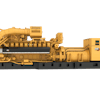
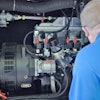

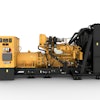
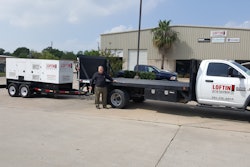
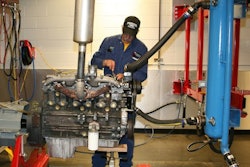
![[VIDEO] Kohler Offers Innovative Way to Parallel Generators](https://img.forconstructionpros.com/files/base/acbm/fcp/image/2016/03/default.56d6fde84ff40.png?auto=format%2Ccompress&fit=crop&h=167&q=70&w=250)




